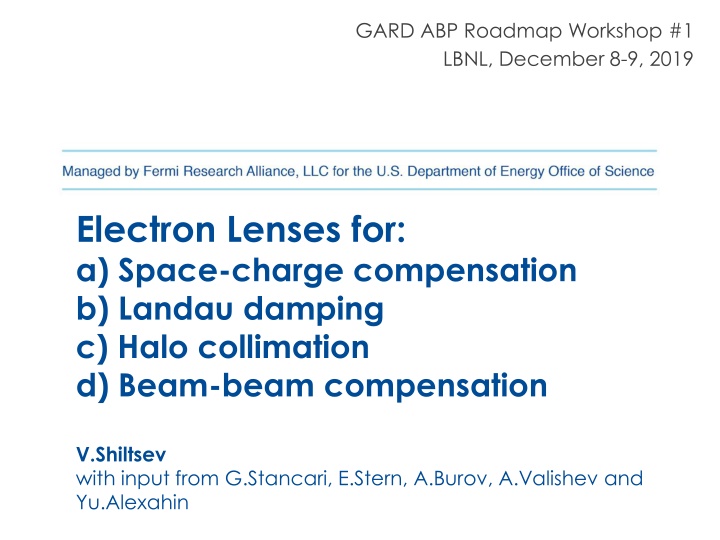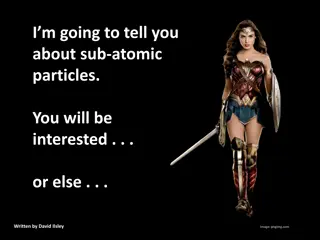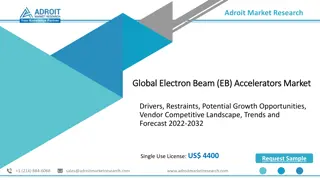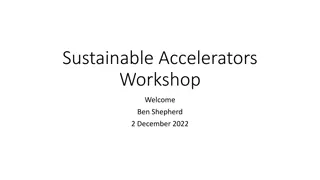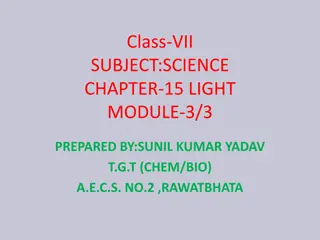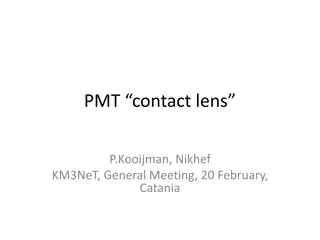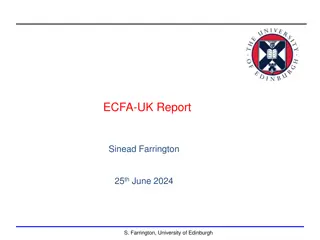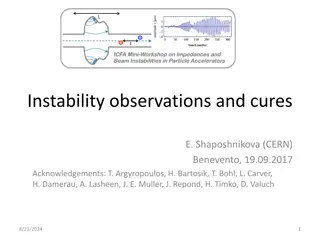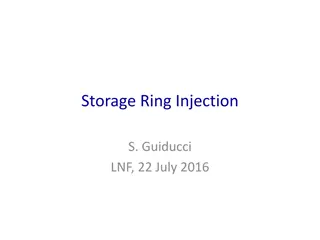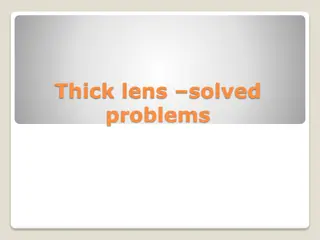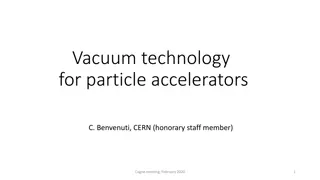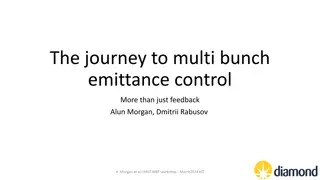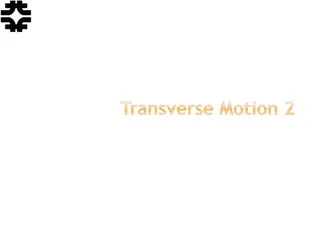Electron Lenses in Particle Accelerators: Advancements and Applications
Explore the use of electron lenses in particle accelerators for space-charge compensation, Landau damping, halo collimation, and beam-beam compensation. Learn about their history, applications in Tevatron and RHIC colliders, and current research areas. Electron lenses have shown promise in enhancing beam quality, compensating for beam-beam effects, and improving collider performance.
Download Presentation

Please find below an Image/Link to download the presentation.
The content on the website is provided AS IS for your information and personal use only. It may not be sold, licensed, or shared on other websites without obtaining consent from the author.If you encounter any issues during the download, it is possible that the publisher has removed the file from their server.
You are allowed to download the files provided on this website for personal or commercial use, subject to the condition that they are used lawfully. All files are the property of their respective owners.
The content on the website is provided AS IS for your information and personal use only. It may not be sold, licensed, or shared on other websites without obtaining consent from the author.
E N D
Presentation Transcript
GARD ABP Roadmap Workshop #1 LBNL, December 8-9, 2019 Electron Lenses for: a) Space-charge compensation b) Landau damping c) Halo collimation d) Beam-beam compensation V.Shiltsev with input from G.Stancari, E.Stern, A.Burov, A.Valishev and Yu.Alexahin
Electron Lens Space Charge Physics Motivation B 2 12/08/2019 Shiltsev | Electron Lenses
Electron Lenses Since 1997 ~4 mm dia 2 m long in 3T solenoid beam of ~10kV ~1A electrons (~1012) can turn on/off in 0.5 usec 3 12/08/2019 Shiltsev | Electron Lenses
Two Electron Lenses Installed in Tevatron TEL-1 in 2001 TEL-2 in 2004 V.Shiltsev, et al, PRST-AB (1997) 4 12/08/2019 Shiltsev | Electron Lenses
What Electron Lenses Are Good For (1) In the Fermilab Tevatron Collider: long-range beam-beam compensation (varied tune shift of individual 1 TeV bunches by 0.003-0.01); Shiltsev et al., Phys. Rev. Lett. 99, 244801 (2007) abort gap collimation (for years in regular operation); Zhang et al., Phys. Rev. ST Accel. Beams 11, 051002 (2008) studies of head-on beam-beam compensation; Shiltsev et al, NJP (2008); Stancari et al., PRL 107, 084802 (2011) demonstration of halo scraping with hollow electron beams; Shiltsev (2006); Stancari et al., Phys. Rev. Lett. 107, 084802 (2011) 5 12/08/2019 Shiltsev | Electron Lenses
What Electron Lenses Are Good For (2) Presently used in RHIC at BNL for head-on beam-beam compensation with significant luminosity gain ~x2 Fischer et al., Phys. Rev. Lett. 115, 264801 (2015) Current areas of research: to compensate space-charge effects in modern RCSs Burov, Foster, Shiltsev (2000), Stern et al, IPAC 18 hollow electron beam collimation of protons in the HL-LHC; Conceptional Design Report, CERN-ACC-2014-0248 (2014) long-range beam-beam compensation as current-bearing wires in the HL-LHC Valishev,Stancari, arXiv:1312.5006; Fartoukh et al., PRSTAB 18, 121001 (2015) generation of nonlinear integrable lattices, eg in IOTA Shiltsev et al, PRSTAB(1997), Nagaitsev, et al., IPAC 12; Stancari et al., IPAC 15 to generate tune spread for Landau damping of instabilities before collisions in the LHC, FCC-hh (>10,000 octupoles), FNAL Recycler Shiltsev (2006), Shiltsev, Alexahin, Burov, Valishev PRL (2018) 12/08/2019 versatile applications depending on e-beam profile + pulsing 6 Shiltsev | Electron Lenses
ABP eLens Topic #1: Compensation of space-charge effects by electron lenses 7 PIC simulations below - by E.Stern, et al (FNAL) 12/08/2019 Shiltsev | Electron Lenses
Tune Footprint dQSC=-0.9 dQSC= - 0.9 dQSC+EL= - 0.2 ~75% e-lens compensation no e-lenses 12/08/2019 Stern et al, THPAF075, IPAC18, Beams Document 6790-v1 FNAL (2019) 8 Shiltsev | Electron Lenses
1000 Turns in a Ring with dQSC=-0.9 Case #1 Ideal ring 1% error Electron lens Case #2 1% error in one quad Focusing Defocusing Case #3 1% error in one quad + 12 e-Lenses 9 12/08/2019 Shiltsev | Electron Lenses
Emittance Growth Case #1 10 12/08/2019 Shiltsev | Electron Lenses
Emittance Growth Case #2 11 12/08/2019 Shiltsev | Electron Lenses
Emittance Growth Case #3 12 12/08/2019 Shiltsev | Electron Lenses
Particle Losses at 4 Case #2 and #3 e-lenses reduce losses ~6 fold ! 13 12/08/2019 Shiltsev | Electron Lenses
Optimal Compensation ~75% (emitt. growth) 14 12/08/2019 Shiltsev | Electron Lenses
Optimal Compensation ~70% (beam losses) 15 12/08/2019 Shiltsev | Electron Lenses
Electron Lens in IOTA 16 Shiltsev | Electron Lenses 12/08/2019
Two Addl Important Variations McMillan eLens Electron Column Use the electromagnetic field generated by the electron distribution to provide the desired nonlinear field. In strong field, ionization electrons mirror transverse profile of protons How does the electron column evolve? 17 Shiltsev | Electron Lenses 12/08/2019
ABP eLens Topic #2 : Coherent Stability A.Burov, Y. Alexahin, V.Shiltsev, A.Valishev For the parameters of the Future Circular Collider, a single conventional electron lens a few meters long would provide stabilization superior to tens of Shiltsev | Electron Lenses thousands of superconducting octupole magnets. . 18 12/08/2019
ABP eLens Topic #3 : Halo Collimation HEBC: Hollow Electron Beam Collimation : Tevatron to LHC 19 Shiltsev | Electron Lenses 12/08/2019
Hollow e-Lens Collimator for HL-LHC HEBC: Hollow Electron Beam Collimation : Tevatron to LHC 20 Shiltsev | Electron Lenses 12/08/2019
Topic #4 : Beam-beam compensation Gaussian e-beams for head-on compensation Broader/smooth edge e-beams for long-range beam-beam compensation Found very effective in the Tevatron (LR-BBC) and RHIC (HO-BBC) Can be very helpful in HL-LHC for LR-BBC: A.Valishev, S.Fartoukh, et al Relatively complex (wrt to Wire LR-BBC Effectiveness for future colliders (EIC and FCChh) Need to be studied RHIC e-Lenses Shiltsev | Electron Lenses 12/08/2019 21
eLens challenges: How can it fail? What can go wrong with this idea? Space-charge compensation risks : Physics of space-charge requires not only transverse matching as in beam- beam compensation but also longitudinal matching of e- and p+ bunches Specs for the SCC are not fully explored yet Specs might be very challenging for practical cost effective eLenses E-lenses for Landau damping risk : Physics and technological risks are limited Hollow eLens Collimation risk: Physics risks is limited Technological risks in generation of the proper beam profile, problem-free bending sections, and proper time modulation eLens beam-beam compensation risks : Physics and technological risks are limited Specs might be very challenging for practical cost effective eLenses (if high A*m are needed for high current colliders) 22 Shiltsev | Electron Lenses 12/08/2019
Facilities: Fermilab and CERN test stands Upgrades CERN electron lens test stand Fermilab elens test stand Phase 1 Phase 2 Operational, up to 10 kV, 8 s x 1Hz pulses (or higher at lower current). Used to test Tevatron and CERN guns, will be used for testing guns for space-charge compensation at IOTA ring. Could be used to test HF modulators. Upgrades needed: for higher intensity, faster modulators and new Diagnostics Box Shiltsev | Electron Lenses profile diagnostics 23 12/08/2019
Electron Lenses and the GARD ABP Grand challenges Grand challenge #1 (beam intensity): How do we increase beam intensities by orders of magnitude? eLens Space-Charge Compensation can lead to factor 2-3-5? in intensity eLens Landau damping can keep narrow beams stable x10-100 Grand challenge #2 (beam quality): How do we increase beam phase-space density by orders of magnitude, towards quantum degeneracy limit? eLens Landau damping can keep superbright beams stable x10-100 eLens Beam-beam/SC compensation can allow x2-5 in and dQSC Grand challenge #3 (beam control): How do we control the beam distribution down to the level of individual particles? eLens Halo collimation can control losses of superbright beams eLens in McMillan form can control beam distribution and losses Grand Challenge #4 (beam prediction): How do we develop predictive virtual particle accelerators ? eLens SC and BBC require arguably the most predictive modeling tools Shiltsev | Electron Lenses Describe an approximate timeline in relation to grand challenges: #1 10-15 yrs; #2 10-20 yrs; #3 5-10 yrs; #4 5-10 yrs (see slide 30) 24 12/08/2019
Electron Lenses and the GARD ABP Missions Advance physics of accelerators and beams to enable future accelerators. Substantially expand intensity/power reach of future multi-MW RCSs via space-charge loss control and luminosity reach of future EF hadron colliders via beam-beam, syability and halo control Develop conventional and advanced accelerator concepts and tools to disrupt existing costly technology paradigms in coordination with other GARD thrusts. eLens SC compensation can allow (less expensive) RCS options for multi-mW beams; inexpensive luminosity increase tools Guide and help to fully exploit science at the GARD beam facilities and operational accelerators. Vigorous eLens program in IOTA; HL-LHC e-beam collimation greatly helps Educate and train future accelerator physicists. eLenses offer unmatched variety for development of existing and new concepts for operational and future accelerators, rich collaborations 25 Shiltsev | Electron Lenses 12/08/2019
Electron Lenses and HEP-Specific Missions Intensity frontier Space-charge compensation can be a game- changer for next generation cost efficient multi-MW machines for neutrino physics (eg PIP-III) Energy frontier: hadron colliders Halo collimation, Landau damping and beam- beam compensation can be a game-changer for next generation hh-Colliders (HL-, HE-LHC, FCChh) Energy frontier: lepton colliders Space-charge compensation will advance proton drivers for muon colliders (MC) Accelerators for physics beyond colliders and Standard Model SC-compensation for cost efficient multi-MW beams 26 Shiltsev | Electron Lenses 12/08/2019
Electron Lenses : Synergies and Connections To other GARD thrusts : High Field Magnets : SC solenoids for eLens beamsize compression Targetry and Sources : AAC : PIC plasma simulations (Space-charge, Beam-beam, Landau damping) To other SC offices : BES : space-charge compensation in protons beams for spallation neutron sources Nuclear Physics : beam-beam and space-charge compensation in EIC; synergy with e-cooling FES : high sield solenoids; PIC plasma simulations (Space-charge, Beam-beam, Landau damping); physics of electron columns/traps 27 Shiltsev | Electron Lenses 12/08/2019
Collaborations: Who is working on this now? Fermilab: Exp/HW/Test stands: G.Stancari, V.Shiltsev, B.Cathey, et al Modeling/Simulations: E.Stern, A.Valishev, A.Burov, et al Collaborating Universities / Labs: LBNL (C.Mitchell, et al), Korea (M.Chung, C.S.Park), RadiaSoft (J.Edelen, C.Hall); Finland (Lapland U.) BNL: W.Fischer, X.Gu, et al CERN: Exp/HW/Test stands: S.Radealli, D.Perini, et al Modeling/Simulations: A.Rossi, S. Sadovich, et al Collaborating Universities/Labs BINP (Novosibirsk): A.Levichev, D.Nikiforov, et al Germany: J.Wagner (Frankfurt), et al China: W.Shao, et al 28 Shiltsev | Electron Lenses 12/08/2019
ABP eLens R&D: Milestones (draft) Space-charge compensation : IOTA eLens installed SCC experimental studies Mod/Sim s on eLens SCC Decision on PIP-III eLens SCC Pre-project & Constr n SCC-PIP-III Electron Lenses for Colliders : Landau Damping exp s RHIC and IOTA 2020-2024 HL-LHC HEBC development HL-LHC HEBC installed Design/Simulation work complete for FCC-hh Landau damping eL, HEBC and beam-beam FCC-hh electron lenses prototypes 2021-2022 2022-2028 2020-2028 2028 ca 2035 2020-2022 2024-2025 2032 2040 29 Shiltsev | Electron Lenses 12/08/2019
Electron Lenses R&D : Possible Roadmap 2020 2025 2030 2035 2040 ELECTRON LENS SPACE CHARGE COMPENSATION dQSC=-1 specs IOTA SCC Experiment MODELING/SIMUL s IOTA Analysis Multi-MW RCS CDR Build / Install 2ndLens? e-column? IOTA EXPERIMENTS Double dQSC? McMillan / Compensation Multi-MW RCS EL Design / Prototyping DESIGN/PROTOTYPING IOTA TDR ELECTRON LENSES FOR ENERGY FRONTIER COLLIDERS SppC Construction 240 GeV Z W CEPC HL-LHC e-Collimator commissioning & studies HL-LHC e-Collimator build & install RHIC PoP exp FCC e-coll. design/ prototyping HALO COLLIMATION RHIC head-on compensation FCC-hh BBC design BEAM-BEAM COMPENS. HL-LHC BBC studies ? HL-LHC LR/HO Modeling FCC-hh design LANDAU DAMPING HL-LHC Modeling IOTA studies HL-LHC studies? Construction 27 TeV ELECTRON LENS TECHNOLOGY AND TEST STANDS HE-LHC R&D, TDR, prototyping, pre-construction FERMILAB TEST STAND Multi-MW RCS & FCC EL Components Prototyping Test Stand HL-LHC IOTA In general, electron lens R&D is of direct relevance to the US HEP priorities for intensity and energy frontier science outlined by 2014 P5 and those foreseen in the 2021 Snowmass report. Electron lenses combine practical feasibility and potential blue-sky high-impact. 30 Shiltsev | Electron Lenses 12/08/2019
Back up slides: Beam Intensity Grand Challenge 31 Shiltsev | Electron Lenses 12/08/2019
x10 Beam Power Grand Challenge Brute force : increase the energy E magnets, RF decrease the cycle time T magnets, RF key challenges : cost (e.g., J-PARC TPC ~$1.7B) and power Increase PPP (protons per pulse) Np: key challenges : many beam dynamics issues & cost In both cases need reliable horns and targets : key challenge : lifetime gets worse with power 32 Shiltsev | Electron Lenses 12/08/2019
Protons Per Pulse no Silver Bullet Increase the injection energy (PIP-II): Gain about Np~ 2, need (often - costly) linacs Flatten the beams (using 2ndharm, RF) : Makes SC force uniform, Np~ x1.5-2 Painting beams at injection: Linearize SC force across beams Np~ x1.5 Better collimation system beams: From ~80% to ~95% Np ~ x1.5 Make focusing lattice perfectly periodic: Eg P=24 in Fermilab Booster, P=3 in JPARC MR Np~ x 1.5 - ? Introduce Non-linear Integrable Optics : Reduces the losses, allows Np~ x 1.5 3? Space-Charge Compensation by electron lenses : Shiltsev | Electron Lenses Electrons to focus protons, Np~ x 1.5 3? 33 12/08/2019
IOTA: Integrable Optics Test Accelerator 34 12/08/2019 Shiltsev | Electron Lenses
Speaker guidelines Emphasize broad forward-looking research topics other than your specific R&D program Focus on your view of future challenges and methods to address those challenges. My abstracts: Electron Lenses for Landau damping . Developments of higher and higher brightness beams call for new methods of the beam stability control. Traditional ways to ensure Landau damping by nonlinear elements, such as eg octupoles, become less efficient for unprecedentedly narrow beams. Electron lenses are considered as an extremely useful and versatile tool for stability control which seems to be free of traditional caveats of reduced dynamic aperture. Space-charge compensation . A 60-years old problem of space-charge limit affects all types of modern hadron accelerators. There are several approaches including active space-charge compensation with electron lenses, electron columns or other means of externally controlled neutralization. It needs to be explored theoretically and experimentally whether indeed the space-charge parameters (figure of merit such as tune shift or tune suppression) can be increased by substantial factors - thus paving the way to new revolutionary accelerators. Shiltsev | Electron Lenses 12/08/2019 35
Slides 1 4: Research idea/proposal Please address the following: Describe the science/R&D that you are proposing to do. Briefly describe present state of the art you presentation should include this! What is the desirable outcome? What are the potential impacts? How does it fit into the GARD ABP missions (see above)? How can it fail? What can go wrong with this idea? Is it testable? What facility? 36 Shiltsev | Electron Lenses 12/08/2019
Slide 5: Grand challenges Which Grand Challenges (see above) is this proposal/idea addressing? Describe an approximate timeline in relation to grand challenges 37 Shiltsev | Electron Lenses 12/08/2019
Slide 6: HEP missions How is your proposed research related to the HEP- specific missions? Intensity frontier Energy frontier: hadron Energy frontier: lepton Accelerators for physics beyond colliders and Standard Model Blue-sky with high-impact and relevance to HEP. 38 Shiltsev | Electron Lenses 12/08/2019
Slide 7-8: Synergies Describe potential synergies and connections to other GARD thrusts and other SC offices (BES, NP, QIS, FES, etc) 39 Shiltsev | Electron Lenses 12/08/2019
Slides 9-10: Timeline (aka the Roadmap) Describe the proposed timeline and associated milestones 40 Shiltsev | Electron Lenses 12/08/2019
Electron Lenses R&D : Approx. Timeline (10 yrs) 2020 2025 2030 Year Shiltsev | Electron Lenses 2020 2025 2030 12/08/2019 41
E-Lenses R&D : Approx. Timeline (next 10 yrs) 2030 2035 2040 Year Shiltsev | Electron Lenses 2030 2035 2040 12/08/2019 42
1000 Turns in a Ring with dQSC=-0.9 Case #1 Focusing Defocusing 43 12/08/2019 Shiltsev | Electron Lenses
1000 Turns in a Ring with dQSC=-0.9 Case #2 1% error Focusing Defocusing 44 12/08/2019 Shiltsev | Electron Lenses
